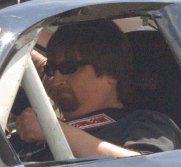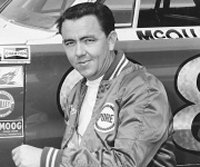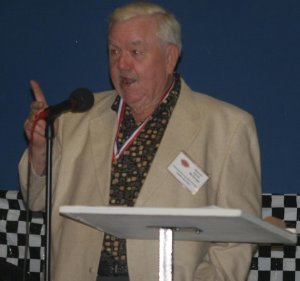
Brandon Reed
By Brandon Reed
Posted in Columns 7/2/09
The field of 43 drivers that take the green flag Saturday night in the annual Pepsi 400 at Daytona International Speedway will be driving cars that are engineered to use aerodynamics to their advantage, helping to obtain higher speed and better stability.
That stability, however, was not something NASCAR stock cars always had at Daytona. As the speeds got faster in the first few years of racing on the big super speedway, the cars became difficult to hang on to.
But in 1966, a Georgia racing Hall of Famer changed all that.

Sam McQuagg roared onto the NASCAR scene in 1965, winning the rookie of the year title.
Sam McQuagg from Columbus, Georgia, began racing in the mid 1950s, winning a spectator race at a small local dirt track in his street car.
McQuagg was hooked on racing from there on, and quit his job working construction to become a full time driver.
He visited victory lane many times at Valdosta and at tracks in Alabama.
McQuagg’s first Grand National (now Sprint Cup) start came at Valdosta in 1962.
In 1965, McQuagg made 14 stats in NASCAR’s top series, and would go on to win the Rookie of the Year title.
His memorable moment from that year came as he was leading the famed Southern 500. His Ford tangled with that of Cale Yarborough, sending Yarborough’s car over the guardrail and out of the racetrack.
Footage of that accident would be shown as part of the opening montage of ABC’s “Wide World of Sports” for several years after.

McQuagg and the 1966 Ray Nichels Dodge that he would pilot to victory at Daytona.
McQuagg had driven Fords in 1965, but his performances caught the eye of the Chrysler racing executives. In 1966, he would pilot Ray Nichels’ number 98 dodge in 16 events.
That year, Dodge decided to fire what would be the opening salvo in what would later be dubbed the “Aero Wars” by rolling out a sloped back Dodge Charger. By all expectations, the slicker back end of the Charger, coupled with the powerful MoPar engines, should have been a dominating combination.
But there was a problem. The Dodge drivers found that as speeds approached about 180 mph, the back end of the fastback Charger would tend to lift up, causing the back tires to spin and making the car teeter on going out of control.
Chrysler’s top engineers went to work on the problem, and came to the conclusion that a strip of metal placed along the back of the car would help stabilize it at high speeds.
In June of that year, McQuagg helped them to test different kind of strips, called spoilers, at Daytona. They found that the spoiler would disturb the air enough to plant the rear tires firmly on the racetrack.

McQuagg was inducted into the Georgia Racing Hall of Fame in October of 2008. Photo by Brandon Reed
When it came time to run the Firecracker 400 on July 4, Dodge had decided to place an inch-and-a-half high spoiler, contoured to the shape of the trunk lid, on the back of their Charges. It was the first time spoilers were allowed by NASCAR.
McQuagg qualified fourth, but had the lead by the time the cars hit the backstretch on the first lap. He would go on to dominate the Independence Day classic. He led 126 of 160 laps, with an average speed of 153.813 miles an hour.
The Aero-Wars were on.
McQuagg was 29 years of age when he won that event. It was his 31st Grand National event. It would also be the only win of his Grand National career.
McQuagg drove 15 races in 1967, splitting rides between Bud Moore’s Mercury and Cotton Owens’ Dodge. After that year, he would make only 11 more starts in his Grand National career.
McQuagg returned to the short tracks of the south, winning races at the Peach Bowl in Atlanta, Valdosta and all over. Away from the track, he was a commercial pilot.

McQuagg shares stories of his racing days and friends during the GRHOF induction banquet in 2008. He passed away in January of 2009. Photo by Brandon Reed
Sam McQuagg was inducted into the Georgia Racing Hall of Fame in October of 2008. He passed away on January 3, 2009 after battling cancer. He was 71.
McQuagg may have only broken into the Grand National victory lane once in his career, but he was far from a “one hit wonder.” His driving prowess made him a contender on any track, anywhere.
But it is for his one victory at Daytona that race drivers and race fans can be grateful. Sam’s bravery and faith in a little strip of metal helped to usher in one of the most exciting times in American automobile racing. Within a year, Ford had introduced their slope-backed Talladega Torinos and Mercury Cyclones. By 1969, Chrysler came back with one of the most exciting and legendary muscle cars ever, the winged Dodge Daytona.
And it all started with a talented racer from Columbus, Georgia.
Brandon Reed is the webmaster and editor for Georgia Racing History.com.
Questions, comments, suggestions? Email us!
This website is not affiliated with or endorsed by the Georgia Racing Hall of Fame or the Georgia Auto Racing Hall of Fame Association, Inc. All content is the intellectual property of the individual authors. All opinions are those of the individual authors. Please do not repost images or text without permission.
